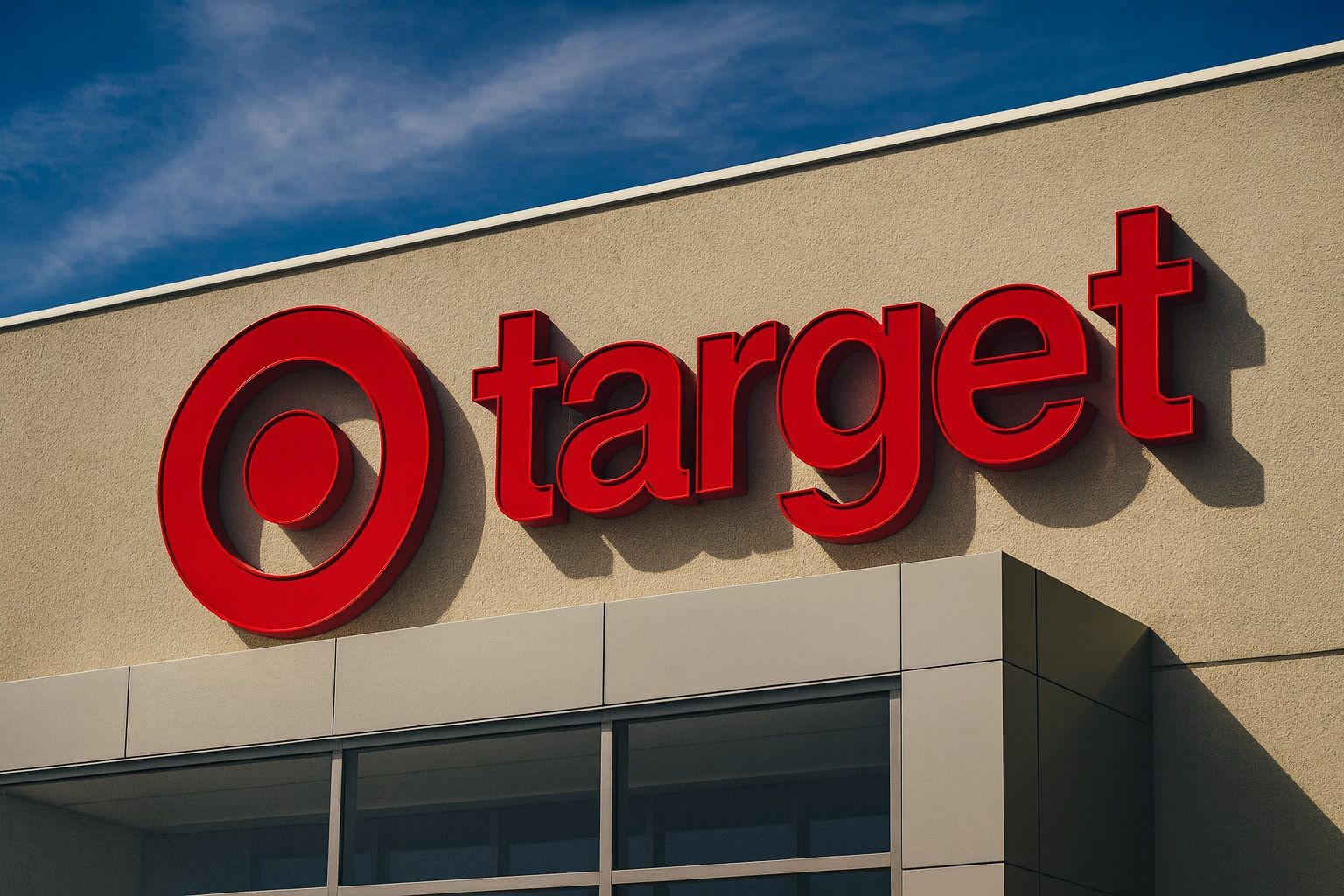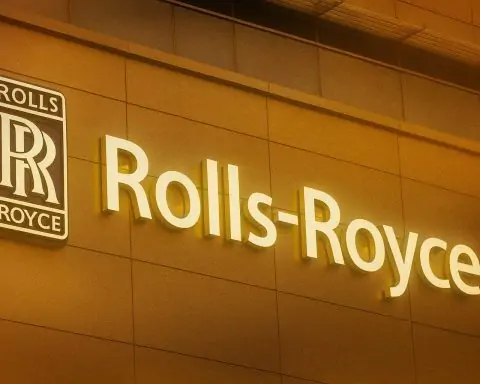Published November 19, 2025
Target (NYSE: TGT) is heading into the critical holiday shopping season under intense pressure after reporting another quarter of declining sales, trimming its profit outlook and unveiling an ambitious turnaround plan built around price cuts, store upgrades and new AI partnerships — including a shopping app inside ChatGPT.
Q3 2025 earnings: sales slip, profit holds up
Target’s third‑quarter fiscal 2025 numbers show a retailer still stuck in reverse on sales, but squeezing enough efficiency out of the business to beat Wall Street’s profit expectations.
According to Target’s earnings release and filings:
- Total revenue fell 1.6% year over year to $25.27 billion, slightly below analyst estimates. [1]
- Comparable sales — stores and digital channels open at least 13 months — declined 2.7%, a steeper drop than the roughly 2.1% decline analysts had forecast. [2]
- Net sales were 1.5% lower than in the same quarter of 2024. [3]
- Adjusted EPS came in at $1.78, beating consensus estimates of about $1.72, but down from $1.85 a year ago. [4]
- GAAP EPS was $1.51, reflecting restructuring and other charges. [5]
The top line was weak, but operating discipline and growth in higher‑margin businesses like advertising helped shore up profit. Reuters notes that Target’s Roundel advertising unit delivered double‑digit sales growth, boosting overall earnings even as revenue slipped. [6]
In pre‑market trading, Target shares were down nearly 2%, extending a year in which the stock has already lost more than one‑third of its value and trades well below peers like Walmart. [7]
Consumers are squeezed by a record U.S. shutdown and sticky inflation
Target’s latest quarter unfolded against a uniquely tough macro backdrop.
The company and analysts say a record‑long U.S. government shutdown delayed federal paychecks and food‑stamp benefits, leaving millions of Americans temporarily short of cash heading into the quarter. [8]
At the same time, inflation remains elevated in key categories and tariff worries are weighing on sentiment, pushing shoppers to:
- Trade down to cheaper groceries and essentials
- Cut back on discretionary items like apparel, home décor and big‑ticket purchases [9]
The Congressional Budget Office has estimated that the shutdown could shave up to $14 billion from U.S. economic output, amplifying pressure on lower‑ and middle‑income households — a critical slice of Target’s customer base. [10]
That squeeze showed up clearly in Target’s mix:
- Household essentials sales fell 3.7%, reflecting pullbacks even in categories that typically hold up better in downturns. [11]
- Shoppers continued spending on food and beverages, where Target reported 7% growth in beverages, but cut back on home and apparel. [12]
One Target investor quoted by Reuters summed up the challenge bluntly: when money is tight, many shoppers simply spend less on what Target sells. [13]
Digital gains and membership momentum — but below expectations
Target’s digital business remains a relative bright spot, but even there the growth story is more “solid” than “spectacular.”
In Q3:
- Digital comparable sales rose 2.4%, driven by more than 35% growth in same‑day delivery through Target Circle 360, the company’s paid membership program. [14]
- That 2.4% digital growth missed Wall Street expectations of roughly 3.2%, highlighting how hard it is to accelerate online momentum in a soft spending environment. [15]
- Non‑merchandise revenue — including ads, memberships and marketplace fees — jumped around 18%, giving Target a more profitable revenue mix even as merchandise sales lagged. [16]
Executives emphasized that same‑day services and membership are central to the strategy. More orders flowing through Drive Up, Order Pickup and same‑day delivery deepen customer loyalty and make stores more efficient as hybrid fulfillment hubs.
A long stretch of weak comps
The latest quarter reinforces a sobering trend: Target has now logged negative or flat comparable‑sales growth in 10 of the last 12 quarters, according to Business Insider’s tally. [17]
Reuters notes that the retailer has not reported any positive same‑store sales growth at all this year, while Walmart continues to gain share by leaning heavily into essentials and low‑priced food. [18]
That persistent underperformance is one big reason the stock trades at about 12 times forward earnings, roughly a 25% discount to its own 10‑year average and far below Walmart’s roughly 35x multiple, according to UBS. [19]
Michael Fiddelke’s turnaround plan: stores, value, and a lot more AI
To break the streak, Target is turning to a familiar insider with a new mandate.
Longtime executive Michael Fiddelke — currently COO and incoming CEO — will officially take the top job in February. He inherits a retailer that has:
- Lost market share to Walmart and Amazon
- Struggled with inventory missteps, understaffed stores and rising theft
- Seen customer satisfaction dinged by inconsistent in‑store experiences and controversial culture‑war blowups [20]
Fiddelke’s plan, as outlined in Target’s own communications and media interviews, has three big pillars:
- Aggressive value positioning
- Heavier investment in stores and operations
- Capex is set to rise to roughly $5 billion in 2026, about a 25% increase versus recent annual levels. [23]
- That money will fund store remodels, new large‑format locations, upgraded fulfillment capabilities and technology improvements.
- Deep integration of AI across the business
- Target is using internal tools like its “Trend Brain” generative AI platform to scan global data for emerging fashion and design trends, shortening product development cycles in categories like apparel. [24]
- AI is also being used in inventory planning, pricing and store operations to reduce out‑of‑stocks and simplify decision‑making.
Target recently cut 1,800 corporate roles, part of a streamlining push meant to free up resources for these growth investments while keeping costs in check. [25]
Target + OpenAI: a new bet on AI‑powered shopping in ChatGPT
One of the most eye‑catching parts of the strategy is Target’s new partnership with OpenAI.
According to Target and OpenAI:
- Target will launch a dedicated Target app inside ChatGPT, built on OpenAI’s new apps platform. [26]
- Shoppers will be able to discover products, fill carts and check out directly within ChatGPT, including:
- Buying multiple items in a single transaction
- Ordering fresh food
- Choosing Drive Up or Order Pickup as fulfillment options [27]
- Target says it will be among the first retailers to support this kind of “agentic” commerce in ChatGPT, alongside new tools like Instant Checkout powered by OpenAI’s Agentic Commerce Protocol. [28]
The company is also rolling out Target Gift Finder, an AI‑powered tool meant to help shoppers quickly sift through thousands of SKUs to find personalized gift ideas during the holidays. [29]
For Target, the OpenAI deal is about more than marketing buzz: it’s a bid to meet customers wherever they are searching — in this case, inside a conversational AI that hundreds of millions now use weekly.
Holiday 2025: deep discounts meet a wary consumer
Even with all the tech and new capital spending, the near‑term story is still about a cautious U.S. consumer.
Target expects fourth‑quarter sales to decline in the low single digits, a weaker trajectory than the sub‑1% decline many analysts were modeling. [30]
That guidance stands in contrast to industry forecasts. S&P Global Ratings, for example, expects overall U.S. holiday retail sales to grow about 4% in 2025 versus 2024, underscoring how Target may underperform the broader sector again this season. [31]
To fight back, Target is leaning hard into value and “meaningful gifting”:
- The chain is featuring thousands of gifts starting at $5 and thousands of toys under $20. [32]
- Category standouts in Q3 included nearly 10% growth in toys and strong momentum in hardlines and food & beverage, tied to seasonal moments like Back‑to‑School and Halloween. [33]
- Executives say shoppers are prioritizing what goes under the tree, not on it — meaning gifts and essentials over décor and big home projects. [34]
Target is also promoting an “Alpine Village” in‑store holiday experience, revamped digital shopping tools like Store Mode and List Scanner, and expanded next‑day delivery to more than half of U.S. households. [35]
Guidance cut: earnings range narrowed as uncertainty lingers
Despite the EPS beat in Q3, Target trimmed its full‑year outlook, acknowledging that the turnaround remains a work in progress.
- The company cut the top end of its 2025 adjusted EPS guidance by $1, now expecting $7.00 to $8.00 per share, excluding severance and other one‑time items. [36]
- That range brackets the current Wall Street consensus of around $7.29, and implies flat‑to‑down profit versus last year despite cost cuts. [37]
Analysts and investors remain skeptical but see some value in the depressed share price. UBS’s Michael Lasser notes that Target is still losing market share but argues that much of the bad news is already reflected in a valuation well below its historical average. [38]
What it means for Target shoppers and investors
For shoppers, the message is straightforward: more discounts, more convenience, and more digital tools — from cheaper staples and toy deals to AI‑powered gift suggestions and shopping inside ChatGPT.
For investors, the picture is more mixed:
- The good news:
- The bad news:
- Sales are shrinking in real terms, and comps remain negative. [41]
- The record U.S. shutdown, stubborn inflation and intense competition from Walmart, Amazon and ultra‑low‑cost e‑commerce players are likely to keep pressure on traffic and margins. [42]
- Management has had to cut guidance again, acknowledging that fixing the business will take time. [43]
The core question now is whether Fiddelke’s combination of lower prices, fresher stores and AI‑driven capabilitiescan reverse nearly three years of weak sales before investors lose patience — and before rivals widen their lead even further.
References
1. www.investing.com, 2. www.investing.com, 3. corporate.target.com, 4. www.investing.com, 5. corporate.target.com, 6. www.investing.com, 7. www.investing.com, 8. www.investing.com, 9. www.investing.com, 10. www.reuters.com, 11. www.investing.com, 12. corporate.target.com, 13. www.reuters.com, 14. corporate.target.com, 15. www.investing.com, 16. www.axios.com, 17. www.businessinsider.com, 18. www.reuters.com, 19. www.reuters.com, 20. www.investing.com, 21. www.reuters.com, 22. corporate.target.com, 23. corporate.target.com, 24. corporate.target.com, 25. www.reuters.com, 26. corporate.target.com, 27. corporate.target.com, 28. openai.com, 29. corporate.target.com, 30. www.axios.com, 31. www.spglobal.com, 32. corporate.target.com, 33. corporate.target.com, 34. www.axios.com, 35. corporate.target.com, 36. www.reuters.com, 37. uk.investing.com, 38. www.reuters.com, 39. www.investing.com, 40. corporate.target.com, 41. www.investing.com, 42. www.investing.com, 43. www.reuters.com








